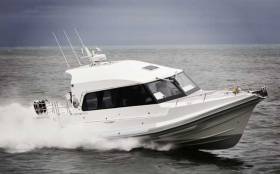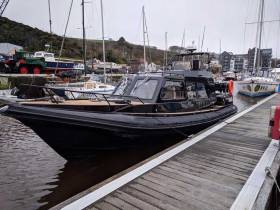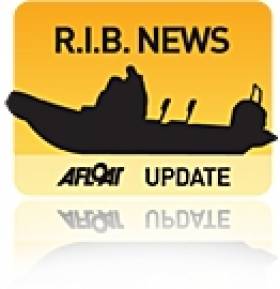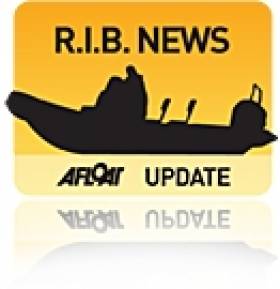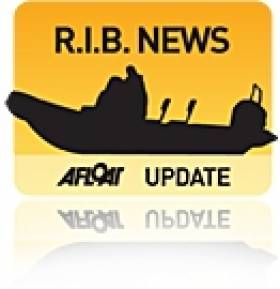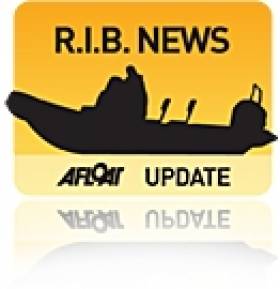Displaying items by tag: RIBs
Glasgow's Ultimate Boat Company is Shortlisted for Environmental Initiative at Metstrade Boat Builder Awards 2021
Glasgow-based The Ultimate Boat Company (UBC) has been shortlisted for the ‘Environmental Initiative’ category of the forthcoming Metstrade Boat Builder Awards as a result of its pioneering use of a revolutionary sustainable technology and material in boatbuilding.
ExoMarineTM, the marine variant of DANUTM, was created by UBC’s parent company, ExoTechnologies, as an alternative to glass-reinforced plastic (GRP) with the goal of combatting the growing problem of old boats being disposed of via landfill, with an estimated 250 million kilos of GRP being dumped in Europe each year.
"An estimated 250 million kilos of glass-reinforced plastic is being dumped in Europe each year"
Comprised of styrene-free resin and sustainable fibres, this breakthrough composite material has exceptional strength and is capable of being recovered, recycled and reused repeatedly. It is stronger and lighter than fibreglass, less brittle than carbon fibre and costs no more to produce than either. The material loses none of its tensile strength when recycled and uses the same vacuum infusion methodology as many existing boat building materials, so requires no additional manufacturing or labour costs.
 The DANU material in production
The DANU material in production
DANUTM is not only capable of accelerating the green transition to circularity for composite materials used in maritime craft but there are several other industry applications being progressed. The development team has produced a ballistic resistant solution (ExoProtectTM) ready for scalable production to commercialise this novel technology and ExoTechnologies is also partnering with the world’s leading organisations to develop a circular solution for the sustainable energy industry (ExoWindTM).
Understandably, the DANUTM development project has attracted considerable attention from other ESG investment funds, multi-national corporations, specialist research institutions, military, law enforcement, media and industry publications.
 A close-up image of the recently launched X-CLASS boat from the Ultimate Boat Company
A close-up image of the recently launched X-CLASS boat from the Ultimate Boat Company
Shane Mugan, CEO of ExoTechnologies, said, “This development project has created a fully-scoped “pathway” for boat manufacturers using conventionally infused composite material to rapidly transition to ExoMarine™. It represents a ‘fit for purpose’ and viable solution in response to this global ecological crisis by providing an accelerated green transition to a circular economy for the maritime industry.”
The Environmental Initiative award, sponsored by Confindustria Nautica, recognises boat builders who have made a significant contribution towards sustainability. The award recognises examples such as recycling initiatives, lifecycle awareness and support of environmental improvement projects. The Boat Builders Awards ceremony will be held at the Metstrade show in Amsterdam on 17 November.
New Red Bay 11.5 metre RIB Arrives in Kenmare, County Kerry
John Brennan of Dromquinna Manor in County Kerry took delivery of a new 11.5 metre rib from Irish RIB manufacturer Red Bay Boats last month. On its maiden voyage, it travelled 440 miles from the boat builders yard in County Antrim home to Kerry without fault in Status Yellow and Small Craft Warnings.
Brennan, a keen powerboater, has been updating Afloat on the new vessel that he maintains is 'unlike any other' on Irish waters.
"I had looked at many manufacturers with various different styles of boats but keep coming back to Redbay for their hulls that suit the Atlantic coast", he told Afloat.ie
 (Above and below) The new RIB alongside at Dromquinna Manor in Kenmare Bay
(Above and below) The new RIB alongside at Dromquinna Manor in Kenmare Bay
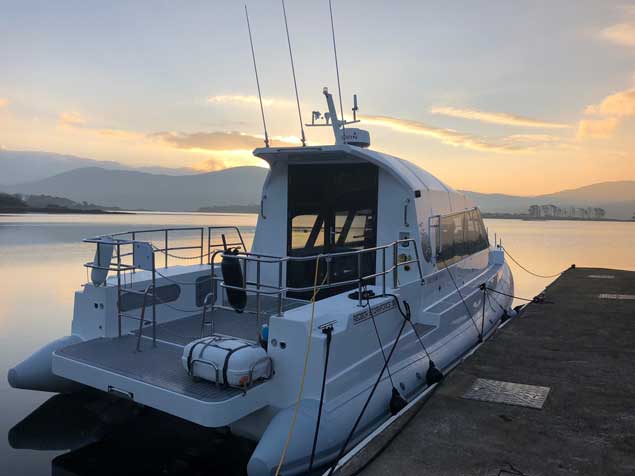
The boat had to fill the role of luxury day cruiser and long distant explorer for two people. Not an easy mix but after many email exchanges, specification details and photos exchanged I think they have produced a unique boat unlike anything else on the water", Brennan told Afloat.ie.
Specifications
Redbay 11.50
Beam 3.8
1200Lt Fuel Tanks, 400 mile range
Twin Yanmar 8LV 370hp with Yanmar ZT370 legs
Docking Yanmar JC 10 Joy Stick on aft deck
Yanmar Emergency backup engine management
Lewmar Vertical Windless with dual controls
Garmin 7412 and 7408 Chartplotters
Garmin 18 HD Radar
Garmin AIS 800
Garmin GMI 20 Wind Pack
Garmin 315 AIS VHF and 115 VHF
Garmin GHC 20 Autopilot
Garmin xdv Sounder P79 in-hull
Garmin Compass
Showerpower
Seaglaze Series 15 Hidden Frame Windows
2 Grammer Avento Air Double Damper Seats
Lenco Electric Trim Tabs
3x110 AGM Gel Batteries with crossover
ROCA Wipers
Electric Air Horn
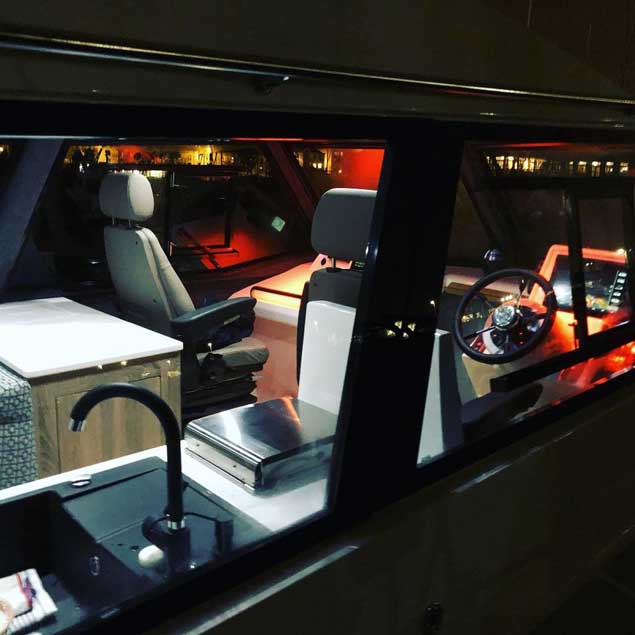
Night Vision Lights
LED Lighting System
Low Level Lighting
USB ports
NASA Clipper Navtex Pro
Eberspacher Heating
Wallas 220D Stove & Heater
Engine Windscreen Demister
Dometic Coolmatic CRX 65S Fridge
Jabsco Pressure Water System
60L Hot Water Tank
Corian Work Tops
Avola Wood Finish in Galley
Egger Macassar Wood Finish in Bedroom
Spradling Marine vinyl headlining
Fabricut Marquette Aquarium Seat Covering internally
Fabricut Klein Square Sunbrella Seat Covering Externally

Fusion Ms-ra 770 Media Player & amplifier
Separate interior and Deck Speaker System
Double Bedroom with Memory Foam Mattress
Electric Toilet with Granite Basin and concealed Shower
Compass LED reading Lights
Sean Kyne TD, Minister with responsibility for the Inland Fisheries sector, today officially launched the first of twelve new state-of-the-art RIBs (Rigid Inflatable Boats) to be delivered on a phased basis to Inland Fisheries Ireland for use as fisheries protection vessels around Ireland’s coastal zone and larger inland lakes.
Minister Kyne was joined at the launch of ‘Delta 1’ at Rathmullan, near Letterkenny, by Joe McHugh TD Minister with responsibility for Gaeilge, Gaeltacht and the Islands, and local public representatives. Delta 1, which will be based in Letterkenny, enters service today.
Minister Kyne said: “The launch of this first vessel marks the Government’s commitment to augmenting IFI’s capabilities for protecting valuable inland fisheries species as they migrate offshore and enhancing protection in larger inland lakes. This is the first in a chain of twelve protection and enforcement vessels to be based around the country. The new RIBs will be phased in over a number of years, replacing the current ageing fleet, at a total cost of €3.3m.”
The new model is the DELTA 780HX Maritime Protection RIB
Currently, IFI has 23 RIBs located around the country, the youngest of which was built and began operations in 2006. The new model is the DELTA 780HX Maritime Protection RIB and was designed and built by Delta Power Services of Stockport, UK, following a competitive tendering process. There were no applications from Irish vessel-building companies.
IFI assembled an expert team to review the tender applications, including members of the RNLI and Irish Water Safety Association. The twelve new RIBs will be named in sequence from Delta 1 through to Delta 12.
Trials of the new RIB model took place in Southampton, UK, in mid-April before the Delta 1 was delivered for crew familiarisation and training in Crosshaven, County Cork, in May.
“The recreational angling sector in Ireland is worth €836m to the Irish economy and supports over 11,000 jobs nationwide,” said Minister Kyne, “so it is vital for the protection of our national fisheries resource that we have a modern RIB fleet capable of conducting patrols and responding rapidly to suspected breaches of our fishing laws. Therefore, I endorsed IFI’s view that the phasing in of a new fleet, which conforms to the highest standards of safety, navigation and communications equipment, is overdue and warranted.”
Minister McHugh added: “I know from my time as Minister with responsibility for Inland Fisheries that the new RIBS will provide the added cost-saving bonus that the older fleet required a system of twin boat patrols - for example, one workboat recovering and confiscating illegal nets with up to three crew, as well as another stand-off boat being present for safety and security with two crew. In contrast, the new IFI model is a single boat patrol vessel with an average of three crew. It is, also, a substantially more sophisticated vessel with a Length Overall of 7.80 metres, and is licensed by the Marine Survey Office to operate to 12-miles. This offers the additional capacity to assist the emergency services if requested.”
The new RIBS will be crewed by fully trained and warranted Fisheries Protection Officers, who also carry the remit to board suspect vessels, as required.
Inland Fisheries Ireland also utilises a number of smaller water-going vessels for fisheries protection on Ireland’s lakes, rivers, and estuaries, including kayaks, jet-skis, and electrofishing and research boats.
Outline specifications of the new DELTA 780HX Maritime Protection RIBs:
Length overall: 7.80m
Beam overall: 2.77m
Draught: 0.18m
Air Draft from waterline: 2.77m
Height on trailer: 3.38m max
Width on trailer: 2.9m max
Engines: Two Yamaha 115 engines, counter-rotating (for stability) with a speed up to 37 Knots
Hull: fibreglass composite.
Red Bay Boats Slick New 11m RIB Arrives in Isle of Man
County Antrim RIB builder Red Bay Boats Ltd has disptached its latest 11m RIB to a new home in the Isle of Man.
The slick black Stormforce 11–metre has twin Yanmar 370z inboard diesels, a joystick control system and two steering positions.
Building Rigid Inflatable Boats for over 30 years, Red Bay's Managing Director Tom McLaughlin now has a range from 5 metres right up to 16m commerical Pilot boats.
The complete range, appropriately named 'Stormforce', trade on their sea-keeping abilities, developed from years of McLaughlin's testing in the rough waters off the Antrim coast.
Also launched this month for some 'serious testing' was "Atlantic Dawn", (see vid below) the all new Stormforce 1050 fitted with the new flagship Suzuki DF350s.
How Round Ireland Swim Inspired Successful RIB Business
#RIB - Tom Prendeville writes in the Sunday Independent about Donegal's Atlantic Composites, whose co-founder Timmy Boyle has built a successful line in "unsinkable" boats.
Boyle, a mechanical engineering fitter by trade, identified a gap in the domestic market for off-the-shelf rigid inflatable boats, or RIBs, while competing in the 2006 Round Ireland Swim.
Few of these boats – commonly used as inshore lifeboats, and perfect for the varying conditions Ireland's coastal waters can throw at them – were being made in Ireland at the time.
So Boyle and a colleague enlisted the help of South African naval architect Kobus Potgieter in developing their first prototype, which faced rigorous sea trials.
The rest, as they say, is history, and the Sunday Independent has much more on the story HERE.
#RIBs - Two top young British sailors are currently in the dock over an incident in Cardiff Bay four years ago in which a young girl suffered severe brain injuries.
As the Daily Mail reports, the girl - who was 11 at the time and has not been named - was one of four youngsters sent flying after two RIBs, piloted by sailing prospects Elleni Morus and Nia Jones, collied in darkness while crossing the bay.
The duo, both aged 17 at the time, were in charge of a group of 24 girls aged from 10 to 14 on a school-break sailing course.
Morus and Jones are accused of acting recklessly before the collision that threw two young girls overboard, a third half-way into the water and a fourth from one boat to the other.
The court heard how the group set out across the bay in four boats, two of them powerful RIBs, to return to their hostel after nightfall, but allegedly did not use lights.
It was also heard that the girls in Jones' speedboat had been encouraging her to drive faster and attempt swerves and wave jumping.
Both parties admit piloting boats without navigation lights but deny failing to travel at a safe speed and failing to keep lookout.
The Daily Mail has more on the story HERE as the trial continues.
Redbay Commercial Ribs Produced By Northern Ireland Firm
Whatever your business, Redbay Boats have many years experience working with the various regulatory bodies to provide safe and seaworthy craft for commercial operations the world over. Projects both in the UK and abroad have included:
- Fishery Protection Vessels
- Ballistically protected drug enforcement vessels
- Coastguard rescue and patrol vessels
- Survey vessels for both seabed and
- environmental applications
- Search and rescue lifeboats
- Fire support and airport rescue vessels
- Navy, military and police vessels
-
Small passenger ferry vessels
The Stormforce range is extensive with RIB boats from 6 to 16 metres in both open boat and weather protected formats. All hulls feature a high dead-rise (deep-V) hull form with spray rails for additional lift, drip and a dry ride. The hulls have an excellent length to beam ratio and a high bow sheer for improved sea keeping. When the superior quality GRP hull is combined with the large diameter inflatable tubes the performance, stability and safety of these boats is unrivalled.
Redbay Boats are committed to building serious commercial RIBs to meet both the demands of our customers and today's stringent regulations.
All RIB's are built in accordance with modern International Stand Organisation (ISO) regulations, required by the various regulatory bodies including the MCA and BV. These include construction (materials, workshop, control and scantlings), Systems (fuel, electrical, fire protection, bilge pumping, steering etc.) and many other specific regulations.
Redbay Boats ISO 9001 Quality Management System covers all aspects from sales, production right through to after sales and in-life support. The system was developed in-house, allowing for optimisation of our production line. Each new build undergoes strict quality management procedures, including up-to-350 point checks through the build program.
This is further reinforced through pre-delivery inspections and sea-trails.
Redbay Boats use only the Scott Bader® matched performance marine system which is fully Lloyd's approved.
"Redbay Boats aims to manufacture and deliver a Best-in-Class product to both its leisure and commercial customers. The company is committed to quality excellence, as well as providing an unrivalled customer service" Redbay Boats Quality Policy
From the formation of the company in 1977, Redbay Boats have been constructing strong, sea-worthy craft. Building on experience and knowledge from the early clinker style wooden boats production of the renowned Fastfisher fishing boats began in the 1980s. By 1993, the first Stormforce Rigid Inflatable Boat (RIB) was built and the RIB range quickly expanded to become one of the most well established and respected brands in the industry.
Redbay is located in the heart of the Glens of Antrim. The location has had a significant bearing on the development of the company and the boats. With the Western Isles of Scotland only 16 miles away, and Rathlin Island with its infamous tidal flows only round the corner, the ideal testing and developing grounds for any boat are on our doorstep. Not only do the boats have to be built to cope with these Atlantic conditions, but safety and comfort of the crew is of utmost importance.
Today Redbay Boats use a perfect combination of dedicated CAD packages with controlled modern construction processes to achieve products that meet the demands and expectations of our customers and ourselves. Traditional values are still evident throughout the company and knowledge is still the best design tool we have.
Redbay Boats is in a continuous cycle of developing and redeveloping the product range, to ensure that we remain at the very forefront of the industry. Many of our staff have valuable sea experience, reflected in the close association with the local RNLI station.
Redbay Boats operate from a modern 20,000 sq ft production facility in County Antrim Northern Ireland. The factory has a dedicated GRP tooling shop, moulding shop, assembly shop and stainless fabrication shop all on site.
With launching and hoisting services on site the company can accommodate all variety of commercial craft through production, re-fit and in-life support activities.
Located just 40 minutes from Belfast International Airport.
Suzuki Shows off new Outboard Engine Joystick Control
#joystick – Suzuki Motor Corporation has announced that it has a new Joystick Control System in development. The announcement was made earlier this month at the 2013 Japan International Boat Show in Yokohama.
The new joystick system is meant to integrate seamlessly with Suzuki's proprietary drive-by-wire system that is available on the Suzuki DF250AP and flagship DF300AP outboard engine models.
During the Japan International Boat Show, the company showed a prototype joystick control as well as concept drawings of the system and its components.(See above)
According to Suzuki, this new system will provide increased confidence to skippers as they manoeuvre their boats in close quarters and will increase the appeal of boating to a 'younger, more tech-savvy demographic'.
Red Bay Boats Launches Second RIB with Hyundai SeasAll Engine
#watermota – Engine, gearbox and generator specialist, WaterMota, has signed Irish RIB builder Redbay Boats, based in Cushendall, Co. Antrim as a new dealer for the Hyundai SeasAll diesel engine range.
Redbay Boats has just launched its second craft fitted with a Hyundai SeasAll engine. The Stormforce 6.5 is fitted with the 250hp S250S version and a Bravo one sterndrive. The boat achieved a top speed of 44 knots in its first sea trial and quickly rose to the plane. A cruising speed of 30 knots @ 3000rpm was achieved.
WaterMota offers a wide range of Industrial radiator cooled and marine heat exchanger/keel cooled propulsion and auxiliary engines, reversing gearboxes, power take-offs, generating sets, custom built power packs, green energy solutions, propellers, sea water pumps, strainers, steering systems, thrusters, batteries and chargers and most engine room installation fittings.
Galway Crew Win RIB Challenge
The competition, which is in its fourth year, was run by the ISA (Irish Sailing Association) along with sponsor Yachtsman euromarine and was open to participants from the ages of 12 to 16. Each team began their training during the summer in preparation for the regional finals which took place in three locations around the country during September. The top 14 teams then progressed to the grand final which took place on Saturday in the National Yacht Club in Dun Laoghaire, Co. Dublin.
The Galway trio faced stiff competition throughout the day from rival teams from Dublin, Wexford, Mayo, Limerick and Cork. They had to complete nine challenges over three hours which focused on different key areas for the safe use of powerboats. The tasks ranged from theory challenges such as 'navigation and pilotage' and 'safety and weather' to on the water challenges where the teams had to demonstrate their boat handling skills and man overboard manoeuvres.
Although the competition was nail-bitingly close, with only two points separating the Galwegians from the runners-up from Foynes Yacht Club, the all-boys team captured the essence of the competition and demonstrated all the skills, knowledge and awareness needed to win and so deservedly took home the grand prize. These skills are paramount for any water user and rewarding those who strive to make our waters a safer place is an honour to both the ISA and Yachtsman euromarine.
The boys credited their success to a number of factors including their coach, Ciaran Oliver, who ensured they practised and studied constantly. Fionn Delahunty, the oldest of the boys, also accredited their win to great team communication and their parents support.




























